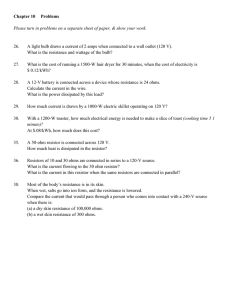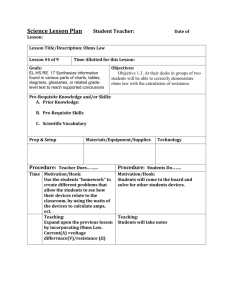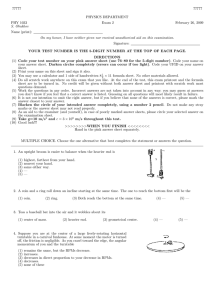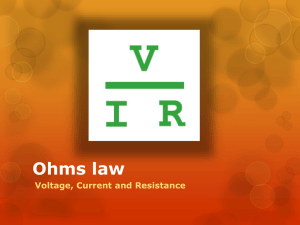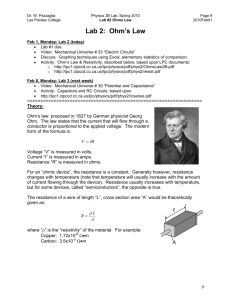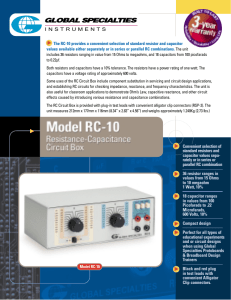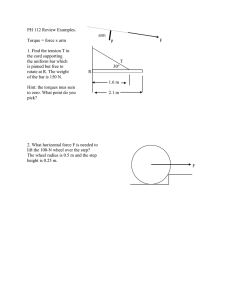Ohm's Law Presentation
advertisement
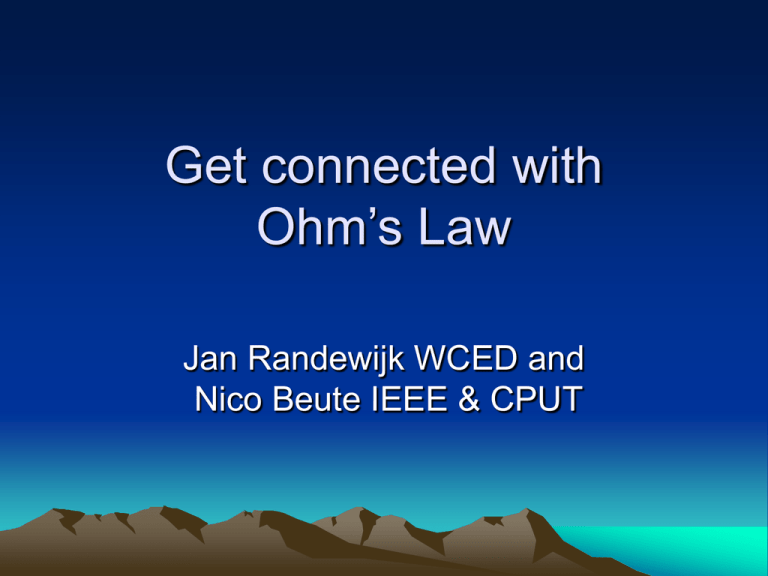
Get connected with
Ohm’s Law
Jan Randewijk WCED and
Nico Beute IEEE & CPUT
Overview
•
•
•
•
•
Introduction
Nico 5 min
Educational issues
Jan 10 min
Documents & materialsNico 5 min
Experiment
Jan 40 min
Conclusion
Nico 10 min
Objective
• To enable engineers to lead a
training session for teachers on an
engineering related topic
Understand
the educational system
– Educational terms
• Curriculum
• Outcomes {CO , DO & LO}
• Assessment standards
– Educational environment
• Knowledge of learners
• Knowledge of teachers
How
• Make it practical – give examples
from the workplace
• Keep it simple
• Try it out today
Educational Issues
Jan Randewijk
• Critical Outcomes
• Developmental Outcomes
• Learning Outcomes
Documentation and Materials
Nico
• Get documents ready before presentation
– The IEEE has a number of well prepared sets
• Update for South African use in consultation with your
education department
– Draw up documents for scratch
– Requirements:
• Must enable teacher to present lesson
• Must consider the educational environment
– Affordable
– Level of knowledge of learners
– Technical knowledge of teachers
Documents
• Introduction
• Curriculum framework and
assessment standards
• Background information for teachers
• Lesson plan guidelines
• Materials required
• Possible extra activities
• Student handout
Materials
•
•
•
•
•
Affordable
Easily obtainable
As practical as possible
Robust
Re-usable
Alignment to National
Curriculum Statements
• Note: All lesson Plans in this series are aligned to the
Further Education and Training (FET) National Curriculum
Statements (NCS) for Electrical Technology.
• National Curriculum Statement builds its Learning
Outcomes for Grades 10 – 12 on the Critical and
Developmental Outcomes that were inspired by the
Constitution and developed through a democratic process.
The Experiment
Jan Randewijk
• Continuity tester (page 19)
• Ohms Law (page 21)
Conclusion
Nico
Practical applications
of Ohm’s Law
• Measure resistance of kettle element and
calculate power rating
– Does it work for a light bulb?
•
•
•
•
Calculate volt-drop in a conductor
-
Your evaluation of this activity
• Documentation
– does it meet educational requirements
– does it give and allow for practical applications
– can it be used by teachers
• clear and understandable guidelines
• Usable handout for students
• Materials
– affordable
– robust
Thank you
Critical Outcomes
•
•
•
•
•
•
As a result of the activities, all learners should develop and
demonstrate the ability to;
identify and solve problems and make decisions using critical and
creative thinking;
work effectively with others as members of a team, group,
organisation and community;
organise and manage themselves and their activities responsibly and
effectively;
collect, analyse, organise and critically evaluate information;
communicate effectively using visual, symbolic and/or language skills
in various modes;
use science and technology effectively and critically showing
responsibility towards the environment and the health of others; and
demonstrate an understanding of the world as a set of related
systems by recognising that problem solving contexts do not exist in
isolation.
The Developmental Outcomes
require learners to be able to:
•
•
•
•
reflect on and explore a variety of strategies to
learn more effectively;
participate as responsible citizens in the life of
local, national and global communities;
be culturally and aesthetically sensitive across a
range of social contexts;
explore education and career opportunities; and
develop entrepreneurial opportunities.
Learning Outcomes
• LO1: Technology, Society and the Environment -
The
learner is able to demonstrate an awareness and understanding
of the interrelationship between Technology, society and the
environment.
• LO2:
Technological Process - The learner is able to
understand and apply the Technological process.
• LO3: Knowledge and Understanding - The learner is able to
demonstrate an understanding of the concepts and principles
related to Electrical Technology.
• LO4: Application of Knowledge - The learner is able to apply
principles and practices related to Electrical Technology.
Link with LOs and ASs of
Electrical Technology Grade 10
As a result of the Get connected with Ohm’s Law activity, all
learners should develop and demonstrate the ability to;
present assignments by means of a variety of
communication media. (10.2.5)
•describe the use and care of tools and measuring
instruments (10.3.2)
•describe the principles of electricity (10.3.4)
•identify and describe the characteristics of electronic
components (10.3.6
Continuity tester
Continuity tester
Figure .2.2
The resistor colour- code chart
Value
Colour
1st Significant
Figure
2nd Significant
Figure
Multiplier
Tolerance
0
Black
0
1
Brown
1
1
10
1%
2
Red
2
2
100
2%
3
Orange
3
3
1000
4
Yellow
4
4
10000
5
Green
5
5
100 000
6
Blue
6
6
1000 000
7
Violet
7
7
10 000 000
8
Grey
8
8
100 000 000
9
White
9
9
1000000000
Silver
10%
Gold
5%
Materials
IEEE Option
Local Supplier
6,3 volt Lamp 150 mA
6,3 Volts 300 mA
Resistor No.1 = 47 ohms
Resistor No.1 = 22 ohms
Resistor No.1 = 100 ohms
Resistor No.1 = 39 ohms
Resistor No.1 = 100 ohms
Resistor No.1 = 47 ohms
